Town Walls
See also: Navan Town Walls under Places tab
Navan's Town Walls
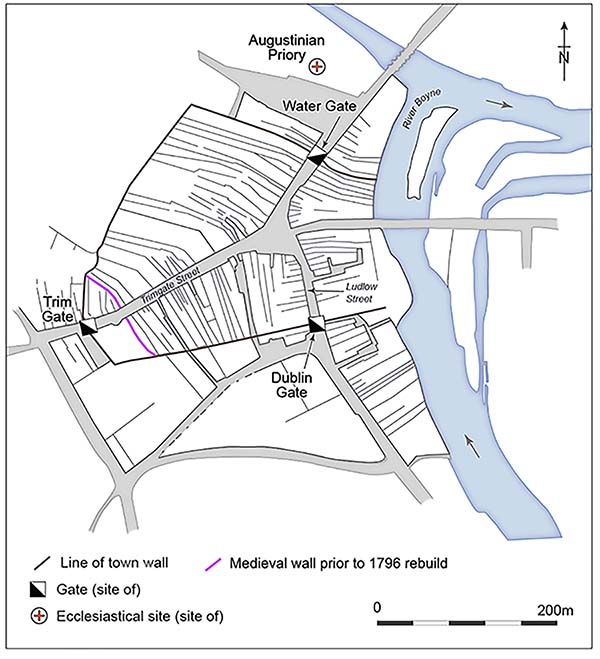
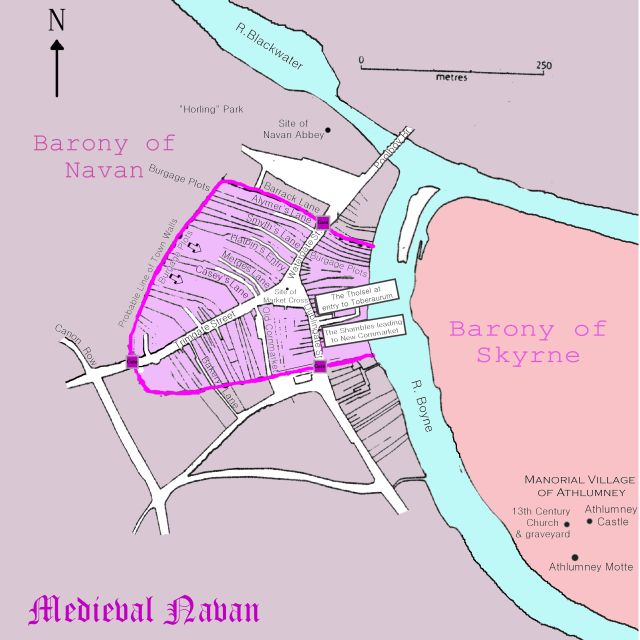
s. Although tradition holds that de Lacy first walled and fortified the town of Navan, this can be dismissed on the compelling grounds that he was dead before the town was established. It is more likely that it was undertaken by one of his followers, Jocelyn de Angulo (or Nangle), to whom the lands of Navan were assigned, and they were rebuilt after the sacking of the town by O' Neill in 1539.
An Act passed at Drogheda in 1542 levied a tax on every ploughland in Meath and Westmeath for this purpose. The Corporation to enter into a bond of £1000 to build within 10 years a wall to be approved by the Deputy and Council.
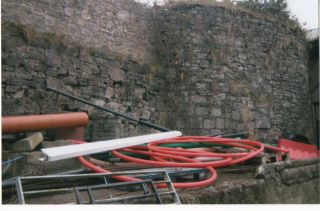
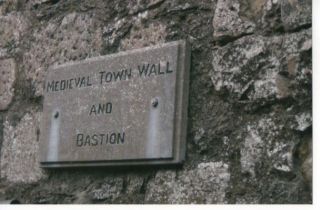
(above) Section of the Navan Town Wall and bastion Co. Co. Yard Abbey Rd
Photos: © Navan & District Historical Society
But the town never seems to have been of great importance as a fortress. It was, however, a noted commercial and market centre from the 17th century onwards. The walls gradually fell into decay, and were only repaired in order to prevent trespass, because
"it appears that the tolls and customs of this Corporation is (sic) likely to suffer greatly by the walls of the sd. Corporation being in a ruinous state, and especially by that part of the wall between Mr. Henry Everard's Tan Yard, and Mr. James Loo's Tan Yard."
Corporation Minutes, 5 February 1746
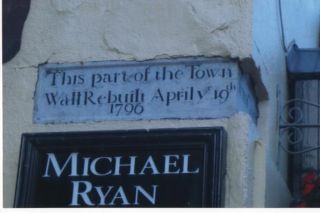
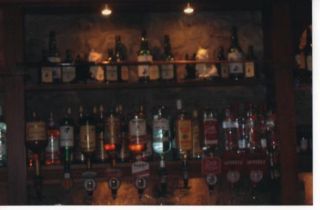
(Above) Plaque for the re-building of the Town Wall due to the widening of Trimgate St. in 1796 and the exposed section of the Town Wall behind the bar in Ryan's pub in Trimgate St. (right)
Photos: © Navan & District Historical Society
The walled town was of comparitively small extent, embracing the areas served by Watergate Street, Dublingate Street (the present Ludlow Street), Trimgate Street and Barrack Lane. Nearly half the population lived oudside the walls in Pollboy, Flower Hill, Butterstream, Canon Row, and Chapel Lane by the 18th century.
A list of households, compiled about 1761, and preserved in Meath Diocesan Registry, shows a total of 2,753 living in all these streets.
The people were packed for the most part into miserable hovels, which lined the numerous narrow alleys opening into the main streets. These thoroughfares were also narrow, and liable to be rutted, and fouled with manure and refuse. The Corporation endeavoured to keep the streets clean, as is shown by the following order: "that the sum of 20 shillings be leveyed of the person who shall suffer any dung, dirt, or mooring to stand or lye at his door longer than three days within the presincts of this Corporation."
Corporation Minutes, 29 September 1760
In 1775 a penalty of 2s/6d was ordered for exposing garbage in the street or shambles. There were, however, vested interests to be considered, even in the province of street cleaning, for it was ordered: "that no person shall take away any dung out of the streets of this Corporation, under a penalty of 5 shillings for every offence, except the Rev. D. A. Beaufort.
Corporation Minutes, 29 September 1775
In 1756 Mr. Richard Dancey was appointed "Schavanger", and supervisor of the lamps, fire materials, well and pump, at a yearly salary of £15; and John Preston the Portreeve, was thanked for "the generous present of lamps, oyle and cotton, buckets, hooks, lather,etc."
Corporation Minutes, 29 September 1756
This would seem to show that not only were the streets lit at night by oil lamps, but also that there was some provision for fighting fires, which would have been highly dangerous in the huddle of thatched cabins. By 1775 these lamps must have been worn out, for by Act of Parliament, it was ordered in that year that £30 be raised to buy lamps and oil, and to pay a lamp lighter.
Corporation Minutes, 28 October 1775
As the century drew to a close a certain amount of rebuilding and street widening took place. Trim Gate was widened, as witness the inscription, illustrated above, still to be seen on the corner of Ryan's Pub: "This part of the town wall rebuilt April 19th, 1796."
John Fay, merchant, was made a Freeman of the town, exempted from tolls and customs, in return for the widening by 10 feet of the Dublin Gate, as part of a building scheme in which he was engaged. But as a Catholic, he could not become a member of the Corporation.
Corporation Minutes, 28 October 1775: John Fay, a man of the highest character and integrity, had a singular talent for business, and "his example and encouragement seemed to have excited a spirit of industry in the town and neighbourhood of Navan."
Belonging to the class of Roman Catholic merchants which had prospered under the provisions of Grattan's Parliament, he became the victim of an outbreak of the spirit of bigotry, which kept the town and district in a state of agitation for more than three months in 1793. Catholic Emancipation was in the air, while in France Louis XVI had been guillotined. Under the influence of the principles of the French Revolution, the Irish peasantry was in a state of ferment.
A secret society, the Defenders, clashed with the Presbyterians of Cavan and North Meath. The movement spread to the rest of Meath, and especially to the district of Kells. The upper class Roman Catholics met at Navan on 28th January, under the chairmanship of their Bishop, Dr. Plunkett, to condemn lawlessness and express loyalty to King and Constitution. Finding however that their resolutions were misreprsented they took no further action.
A certain Rev. Mr. Butler, a magistrate, and Chaplin to the Church of Ireland Bishop Maxwell, was foremost in the suppression of the movement and the imprisonment of its leaders. Though repeatedly warned of his danger, he took no precautions for his own safety, and while riding alone near the back gate of the Bishop's residence at Ardbraccan he was shot through the body from behind a hedge. He managed to reach the house, but died the next day. The murder caused a fresh outbreak of sectarian conflict. The chief men of the County met at Navan and offered a large reward for information as to the identity of the assassin.
Moderate counsels were over-ruled and a secret committee formed, which excluded all Roman Catholics. Wild rumours were spread of of an immenent massacre of Protestants in the town. According to these stories, thay were to be killed in their Church on the Lord's Day and their heads carried on poles round the town, after the French fashion.
Mr. Fay was made a scapegoat by the extremists, who wished to destroy the prosperous (Catholic) Navan merchants. He was arrested in the street on a Market Day, while the military terrorised the houses of the local farmers in a search for unlicensed arms. Certain common informers, under duress, accused Mr. Fay and other reputable inhabitants of the town of complicity in the murder of Mr. Butler. But "the formidable charges of sedition ... ended most miserably at the Assizes at Trim. The fable of the mountain in labour was never more truly realised. Nothing appeared but malice, prejudice, and falsehood, and in the most infamous practices, so that not only the venerable Judge on the Bench, but every man of honour and probity present was shocked."
The above is a precis of A candid and impartial account of the Disturbances in the County of Meath in the years 1792-'93-'94, by a County Meath Freeholder. (Printed in Dublin by N. Kelly, 6 S. Gt. George's St., Price a British shilling), from which it appears that Mr. Fay was acquitted.
John Cusack, distiller, was given a like privilege for widening the Water Gate by 6 feet. Corporation Minutes, 1788.
The 1654 Civil Survey mentiones "Fleshings Gate" and "Swynes Bridge", possibly to be identified with Watergate and Pollboy Bridge.
Patrick Murphy and James Duff were also exempted from tolls, for no stated reason. The confining of the freedom of the town to members of the Ascendancy was now over, so far as trade was concerned.
*******